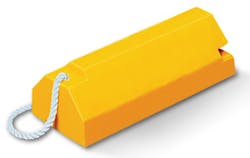Since 1987 Checkers Industrial Products has been involved in developing a new generation of wheel chocks for the US Air Force. According to Steve Henry, president, "Checkers realized early on that we could save the government huge amounts of money in chock replacement and maintenance costs by developing an impact absorbing urethane wheel chock that would not cause FOD problems."
The Old Way
Traditionally, the Air Force utilized wooden wheel chocks regulated by 42D6594, written in 1941 and amended in 1981. No performance requirements were set forth in this specification; details were limited to chock dimensions and criteria concerning splinters and paint.
Not surprisingly, wood chocks presented several serious problems on the flight line. Since wood absorbs moisture and aircraft fluids, they can retain molds and bacteria. Also, wood freezes and ensuing moisture adds significant weight to the chocks. Wood begins to erode and chunks begin to break off, thus causing a Foreign Object Debris (FOD) problem.
Over the years a multitude of chocks appeared on Air Force flight lines as individual squadrons sought alternatives to the traditional wood chock. The many different chocks were not regulated by a specific Air Force directive or specification.
In 2002, two ground safety mishaps caused significant damage to US Air Force aircraft. After these incidents, Warner Robin Air Logistics Center published MIL-PRF-32058 to enhance safety and standardization of wheel chocks. This 2003 directive details very specific design and performance criteria for all wheel chocks.
Specifically, Type I chocks are to be made of soft wood and Type II chocks are to be made of any material other than wood. The specification also provides for three chock classifications, as follows:
- Class A chocks — For dry, wet and ice-free weather conditions.
- Class B chocks — For heavy snow and icy weather conditions.
- Class C chocks — For all weather conditions.
New Technology
Extensive laboratory and field-testing of chock designs and materials were conducted by Checkers for approximately five years to determine service suitability. Various Air Force bases around the world, along with independent labs, put the new chocks to work in a wide variety of environmental conditions. As a result, TIGERCHOCKS™ became recognized as being superior to the wood or rubber chocks used in the past.
Checkers Industrial Products' TIGERCHOCKS™ can be used as Type II, Class B chocks after being evaluated against all requirements of the most recent specification. This means that any Air Force unit may now procure TIGERCHOCKS™ and put them into operation. This also allows units that have previously been using TIGERCHOCKS™ to continue to do so without interruption.
TIGERCHOCKS™ offer superior performance because they are virtually maintenance free and eliminate FOD issues. They are made from UV stabilized urethane in bright aviation safety yellow and resist chemicals, fuels and oils. TIGERCHOCKS™ proven track record with airframes ranging from the T-1 and F-16 to the KC-135 and B747 make them a logical solution to safety challenges faced on flight lines the world over. TIGERCHOCKS™ will provide the Air Force with significant financial and labor savings over the life of each chock. If procured in the right quantities, TIGERCHOCKS™ will save time, equipment, money and lives.
Checkers Industrial Products Inc. is a Small Business and offers TIGERCHOCKS™ on GSA Contract: GS-07F-0301J.





